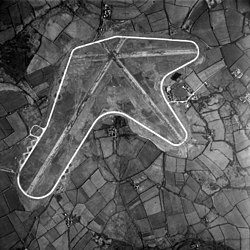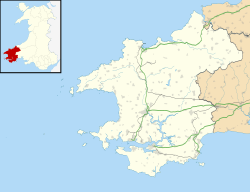| RAF Brawdy RNAS Brawdy HMS Goldcrest | |
|---|---|
| Brawdy, Pembrokeshire | |
 RAF Brawdy in 1944 | |
| Type | Royal Air Force installation |
| Site information | |
| Owner | Ministry of Defence |
| Controlled by |
|
| Site history | |
| Built | 1944 |
| In use | 1944-1992 |
| Battles/wars |
Second World War Cold War |
RAF Brawdy is a former Royal Air Force satellite station located 6.3 miles (10.1 km) east of St Davids, Pembrokeshire and 9.8 miles (15.8 km) south west of Fishguard, Pembrokeshire, Wales.
It was operational between 1944 and 1992 being used by both the Royal Air Force and the Royal Navy before the site was turned over to the British Army and was named Cawdor Barracks.
History[]
The Pembrokeshire base was officially opened on 2 February 1944 as a satellite station for the nearby RAF St. David's with No. 517 Squadron RAF moving in a day before with the Handley Page Halifax Mk V before changing to the Mk III in March 1945. The squadron moved to RAF Chivenor on 30 November 1945.[1] The next squadron to move in was 521 Squadron from December 1944 until May 1945 as a detachment operating the Boeing Fortress II.[2] Between 2 February 1944 and 27 April 1946 595 Squadron aircraft may have been based here with a variety of aircraft as a detachment.[3]
Fleet Air Arm use[]
On 1 January 1946 the station was handed over to the Fleet Air Arm of the Royal Navy and was initially used as a Relief Landing Ground for RNAS Dale. It was commissioned as HMS Goldcrest on 4 September 1952 and in March 1953 the first Hawker Sea Hawk entered service with 806 Naval Air Squadron at RNAS Brawdy. From 1963 till 1971 Fairey Gannets and Hawker Hunters were based at Brawdy in 849 NAS and 738/759 NAS respectively. The Gannets were primarily used in Airborne Early Warning (AEW) and the Hunters for advanced flying training including low-level Navigation, ground attack and air-to-air weapons training. The Royal Navy left in 1971 and the base was allocated to the Department of the Environment.[citation needed]

Sea Hawk F1s of 898 Naval Air Squadron at RNAS Brawdy, 1954.
Back to Royal Air Force control[]
In February 1974 the Royal Air Force returned with D Flight[citation needed] of 22 Squadron taking up residence with their Westland Whirlwind HAR.10 search and rescue helicopters.[4] In September of the same year No. 229 Operational Conversion Unit (later the Tactical Weapons Unit) joined D Flight having been forced to relocate after the closure of RAF Chivenor.[citation needed]
The base was home to Hawker Hunter aircraft of the TWU, and the gate guardian at the base was initially a Supermarine Spitfire, this was replaced in the early 80s by Hawker Hunter FGA.9 (XE624). This airframe was subsequently sold to Steve Petch, a private collector.[5]
Between 1 September 1976 and July 1978 a detachment of 202 Squadron flying Whirlwind HAR.10s used the airfield.[6]
By the late 1980s it operated BAe Hawk T.1A (234 and 79 Squadron).[citation needed] The RAF withdrew in 1992 and the base, now known as Cawdor Barracks, is currently occupied by the Royal Signals, being the main electronic warfare base of the British Army.[citation needed]
In September 1988 the married quarter housing estate for RAF Brawdy which was located on the St Davids Estate at nearby Haverfordwest was sold to The Welbeck Estate Group.
[]
In April 1974 a United States Navy SOSUS station, known as NAVFAC Brawdy, was built adjacent to the RAF base. In 1995 the Joint Maritime Facility at St. Mawgan in Cornwall replaced NAVFAC Brawdy and the facility was deactivated on 1 October 1995.[citation needed]
Current use[]
Until 2018, the barracks is home to the 14th Signal Regiment ("14 Signals"), the British Army's electronic warfare unit.[7] The Regiment has a HQ squadron[8] and five signal squadrons,[citation needed] one of which is based at RAF Digby:[9]
- 14th Signal Regiment (Electronic Warfare)
Under plans announced in early 2013, Cawdor Barracks will be closed in 2018 and 14 Signals will relocate to MOD St Athan, near Cardiff. The site will then be sold for development. The reasons cited for the closure are cost savings and operational benefits from being based with other Army units.[10]
References[]
Citations[]
- ↑ Jefford 2001, p. 95.
- ↑ Jefford 2001, p. 96.
- ↑ Jefford 2001, p. 97.
- ↑ Jefford 2001, p. 32.
- ↑ Cold War Jets Collection, Accessed 31 Jan 2007
- ↑ Jefford 2001, p. 68.
- ↑ "14 Sig Regt (EW)". British Army. http://www.army.mod.uk/signals/25274.aspx. Retrieved 13 June 2013.
- ↑ 8.0 8.1 8.2 "Regimental History". British Army. http://www.army.mod.uk/documents/general/14_SR_Regimental_History.pdf. Retrieved 13 June 2013.
- ↑ 9.0 9.1 "224 Signal Squadron". Royal Air Force. http://www.raf.mod.uk/rafdigby/aboutus/224signalsquadron.cfm. Retrieved 13 June 2013.
- ↑ "Cawdor Barracks "not fit for purpose" and WILL close after 2018". Western Telegraph. 5 March 2013. http://www.westerntelegraph.co.uk/news/10267535.Cawdor_Barracks__not_fit_for_purpose__and_WILL_close_after_2018/. Retrieved 12 April 2013.
Bibliography[]
- Jefford, C.G, MBE, BA, RAF (Retd). RAF Squadrons, a Comprehensive Record of the Movement and Equipment of all RAF Squadrons and their Antecedents since 1912. Shrewsbury, Shropshire, UK: Airlife Publishing, 2001. ISBN 1-84037-141-2.
External links[]
- Airliners.net Photo Gallery of Aircraft at RAF Brawdy
- Air Britain Photo Gallery of Aircraft at RAF Brawdy
- Ivor "Taff" Davies Photo Gallery of Aircraft at RAF Brawdy
- Jet Photos.net Photo Gallery of Aircraft at RAF Brawdy
- XE624.org - Home of the ex-RAF Brawdy Gate Guard Hunter FGA.9
- United States Navy - NAVFAC Brawdy
- 1986 Phantom Aircrash Raf Brawdy
- RAF Brawdy, Wales 1985 ~ 1987 Air Shows
| ||||||||||||||||||||||||||||||||
The original article can be found at RAF Brawdy and the edit history here.

